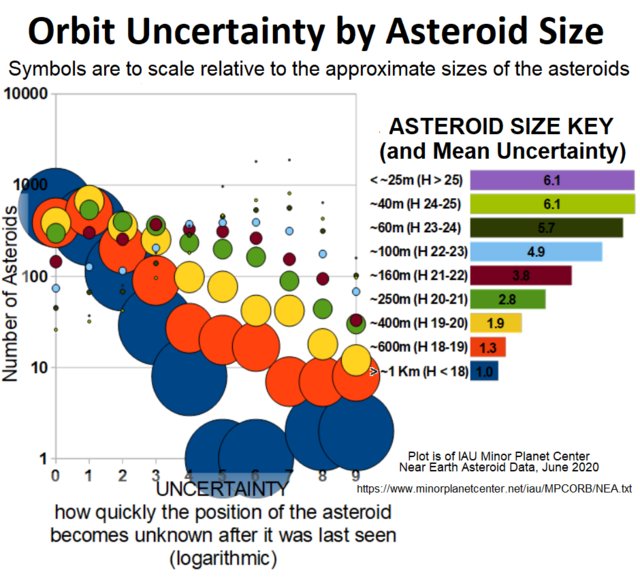Top Qs
Timeline
Chat
Perspective
Uncertainty parameter
Parameter introduced by the Minor Planet Center From Wikipedia, the free encyclopedia
Remove ads
The uncertainty parameter U is introduced by the Minor Planet Center (MPC) to quantify the uncertainty of a perturbed orbital solution for a minor planet.[2][3] The parameter is a logarithmic scale from 0 to 9 that measures the anticipated longitudinal uncertainty[4] in the minor planet's mean anomaly after 10 years.[2][3][5] The larger the number, the larger the uncertainty. The uncertainty parameter is also known as condition code in JPL's Small-Body Database Browser.[3][5][6] The U value should not be used as a predictor for the uncertainty in the future motion of near-Earth objects.[2]

Remove ads
Orbital uncertainty
Summarize
Perspective
Orbital uncertainty is related to several parameters used in the orbit determination process including the number of observations (measurements), the time spanned by those observations (observation arc), the quality of the observations (e.g. radar vs. optical), and the geometry of the observations. Of these parameters, the time spanned by the observations generally has the greatest effect on the orbital uncertainty.[8]
Occasionally, the Minor Planet Center substitutes a letter-code (‘D’, ‘E’, ‘F’) for the uncertainty parameter.
Remove ads
Calculation
Summarize
Perspective
The U parameter is calculated in two steps.[2][10] First the in-orbit longitude runoff in seconds of arc per decade is calculated, (i.e. the discrepancy between the observed and calculated position extrapolated over ten years):
with
uncertainty in the perihelion time in days eccentricity of the determined orbit orbital period in years uncertainty in the orbital period in days , Gaussian gravitational constant, converted to degrees
Then, the obtained in-orbit longitude runoff is converted to the "uncertainty parameter" U, which is an integer between 0 and 9. The calculated number can be less than 0 or more than 9, but in those cases either 0 or 9 is used instead. The formula for cutting off the calculated value of U is
For instance: As of 10 September 2016, Ceres technically has an uncertainty of around −2.6, but is instead displayed as the minimal 0.
The result is the same regardless of the choice of base for the logarithm, so long as the same logarithm is used throughout the formula; e.g. for "log" = log10, loge, ln, or log2 the calculated value of U remains the same if the logarithm is the same in both places in the formula.

648 000 is the number of arc seconds in a half circle, so a value greater than 9 would be meaningless as we would have no idea where the object will be in 10 years within the orbit.
Remove ads
References
Wikiwand - on
Seamless Wikipedia browsing. On steroids.
Remove ads









